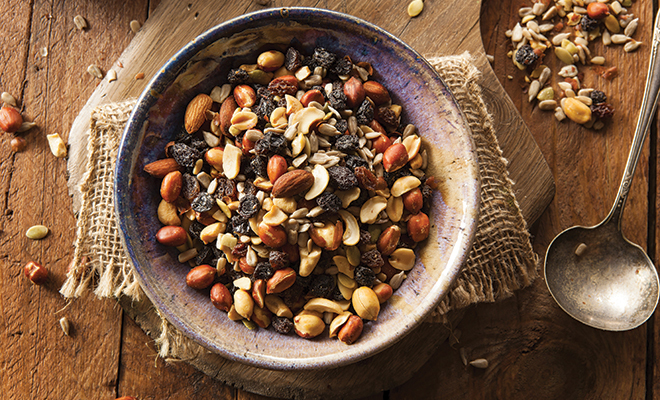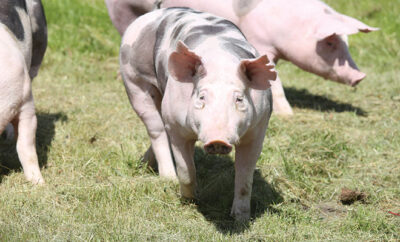
Snacks and your family emergency plan
I think we all agree that fresh, whole foods are healthy. Proteins, fruits and vegetables that are at their peak of flavor and freshness deliver the nutrients, vitamins and fiber that our bodies need. Processed foods, in contrast, are often loaded with additional salt, sugar and fat, as well as other additives designed to improve flavor, appearance and shelf life of the product.
However, there is a time and a place for everything, including processed foods. Whenever I travel, I have favorite go-to snacks that are convenient and easy to tuck into a bag or a purse. Travel can be a great adventure, but part of that adventure is not knowing what unexpected things might happen.
We’ve all either experienced or heard about a five-hour trip that evolved into a 25-hour ordeal. Delays can occur whether you travel by car, plane, train or bus. There are no guarantees you’ll find food or lodging during these delays; you may be bunking in an airport overnight, or getting a hotel room late at night after restaurants have closed.
If you’ve ever found yourself in one of these situations, I’m betting it was educational. Simple snacks can save the day. A few packages of energy bars or jerky, or unsalted nuts and bottled water are a must. I personally plan for 24 hours of unexpected delay.
But why bother with packing snacks and water if the chance of travel delay is slim? Another unhappy possibility is that your destination may present unknown obstacles. A power outage may leave you stranded, unable to purchase gas for your car. A host who unexpectedly becomes ill may leave you on your own in a strange town. In instances like these, having a few healthy snacks on hand can help you stay put overnight rather than venturing out alone to find a grocery or restaurant.
Of course, unpleasant surprises can occur while you’re at home, too–wildfires, floods, blizzards, ice storms, mud slides, tornadoes, hurricanes or earthquakes. If you’re in an area that is experiencing an emergency, your family will not be the only one affected. Most communities quickly offer shelter and assistance to people in the event of a natural disaster. Still, it’s wise to think ahead and develop your own emergency plan.
Our country’s heritage involved planning for worst-case scenarios. As settlers headed west, the pioneer spirit required planning for the worst while hoping for the best. This is true of modern history as well; the threat of nuclear war in the 1950s inspired families to consider building bomb shelters, stocking enough food and water to sustain a nuclear attack. More recently, the Y2K phenomenon at the end of the 20th century generated panic based on worldwide fear that computer systems would cease to function properly after midnight on December 31, 1999. Doomsayers predicted that the entire power grid would fail. Many people chose to stockpile food, water and money as a hedge against this potential disaster, which never materialized.
The good news is that there are countless resources for short- and long-term emergency planning. Google “emergency food storage” and you’ll find millions of options, many of them elaborate and costly. However, NASA suggests a simple emergency food plan for its employees: a basic three-day supply of nonperishable food and water, consisting of one gallon of water per person, and pet, per day.
Stored goods must be replaced to prevent spoilage, so think about cycling these items into your pantry a couple of times a year. One way to remember to do this is to replace stored goods with fresh supplies when you set your clocks for Daylight Savings Time.
Before you shop, consider how you’ll use the food you buy. Do you have a propane grill or camping stove that you can use for cooking? If so, you have more options. If not, choose foods that can be eaten straight from a jar, can, box or bag.
Another decision is where and how to store these goods. Think about using backpacks or small plastic tubs that you can quickly grab and carry if you need to evacuate your home in a hurry. If you must store food in a vehicle, protect it from temperature extremes.
With a little bit of thought and planning, you and your family can be ready with nourishment in case an emergency occurs. HLM
Sources: nasa.gov, cdc.gov and happypreppers.com.
Here’s a list of food and other items to consider for emergency storage plans.
– High-protein energy bars
– Canned goods: meat, fruit, vegetables, beans, sauces, broth, soups
– Dry goods: rice, beans, oats, pasta, dried and powdered soups
– Peanut butter
– Trail mix
– Water: check camping supply stores for safe water storage containers
– Beverages: instant drink mixes, tea, coffee, bottled water
– Pet food: don’t forget your critters will need to eat, too!
– Freeze-dried dairy: milk, cheese and eggs
– Medications: prescription and over-the-counter
– Basic first aid kit
– Battery-operated radio
– Flashlight or LED lantern







